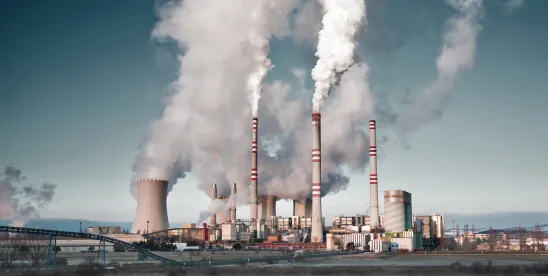INTRODUCTION
The United States Environmental Protection Agency (EPA) recently finalized four separate rules1 (Power Plant Rules) that set new standards for power plant emissions in the United States. Collectively, these Power Plant Rules are a latticework of regulation focused on four areas of potential contamination and seek to limit emissions from natural gas and coal energy generation and derivative sources.
The Power Plant Rules fulfill EPA’s promise to “protect all communities from pollution and improve public health without disrupting the delivery of reliable electricity.”2 EPA also hopes that these rules provide a level of regulatory certainty to help the power sector transition to a clean energy economy.3 Ideally, the Power Plant Rules will provide a predictable regulatory outlook for power companies, opportunities to reduce compliance complexity, and clear signals to create market and price stability. However, opponents to the Rules argue that the new standards will impede the power sector’s ability to meet the increasing energy demand needed to power data centers and clean-technology factories.
CARBON POLLUTION STANDARDS FOR NEW GAS AND EXISTING COAL POWER PLANTS
EPA issued a final rule for existing coal-fired and new natural gas-fired power plants. The rule requires all coal-fired plants intending to operate past 2039, and all new baseload gas-fired plants, to employ best system of emissions reduction (BSER) to control 90% of their carbon emissions based on carbon capture and sequestration (CCS).4 Notably, the rule does not assume that new gas plants can switch to low-emissions hydrogen generation to comply. Electric generating units (EGUs) that cease operations before 2039 will be limited to 40% natural gas cofiring by 2030.5 EGUs that demonstrate that they plan to cease operations before 2032 will have no emission reduction obligations.6 These thresholds have some limited flexibility. Each state has the ability to provide a variance for individual pollution sources based on a series of factors, including the remaining useful life of the EGU.7
In addition to these finalized guidelines, EPA opened a nonregulatory docket to gather input about how to best reduce greenhouse gas emissions from the existing gas combustion infrastructure.8
EPA attempted to address the Supreme Court’s decision in West Virginia v. EPA—a 2022 case that announced the “major questions doctrine,” which is a judicial rule that limits federal agencies from passing regulations with “vast economic and political significance” without clear Congressional authorization.9 Using the major questions doctrine, West Virginia rejected the EPA’s assertion of authority underlying its 2015 Clean Power Plan (CPP). In the CPP, EPA read section 111 of the Clean Air Act (CAA)’s BSER language to include “generation shifting.”10 The Supreme Court found that this reading of the BSER raised a “major question” because it would essentially allow the EPA to shut down coal power plants altogether, substantially restructuring the American energy market. In the face of this major question, the court concluded that Congress had not clearly authorized a regulation of such magnitude.
In its current rulemaking, EPA noted that the West Virginia decision declined to address the lower court’s conclusion that CAA section 111 does not limit the type of system that EPA could consider as the BSER at an individual source.11 In EPA’s view, the Supreme Court confirmed that section 111 authorizes the EPA to determine the BSER and the degree of emission limitation that state plans must achieve.12 Accordingly, in this final rule, EPA specifically considers CCS as the BSER by which to measure emissions reduction, which it contends, is not in conflict with West Virgina v. EPA.13 EPA asserts that this final rule is consistent with the West Virgina decision and does not implicate the major questions doctrine.
MERCURY AND AIR TOXICS STANDARDS
EPA also issued a final rule strengthening and updating the Mercury and Air Toxics Standards for coal-fired power plants, tightening the emissions standard for toxic metals by 67% and finalizing a 70% reduction in the emissions standard for mercury from existing lignite-fired sources (i.e., brown coal burning sources).14 Following EPA’s latest assessment of available control technologies, EPA is also limiting the nonmercury hazardous air pollutants (HAP) metals from existing coal-fired power plants by significantly reducing the emission standard for filterable particulate matter to two-thirds reduced rate, which is a surrogate emission standard to control nonmercury HAP metals.15 In addition, EPA will require the use of continuous emission monitoring systems to provide real-time data to regulators, facility operators, and the public to ensure compliance. This is the most stringent update since the Obama administration first issued the Mercury and Air Toxics Standards in 2012; EPA anticipates that the rule will reduce the mercury emissions from lignite by more than two-thirds.16
LIMITS ON WATER POLLUTION FROM POWER PLANTS
EPA issued another rule to reduce pollutants discharged through wastewater from coal-fired power plants by more than 660 million pounds per year.17 Introducing “Effluent Limitations Guidelines and Standards” (ELGs), EPA created national industry-specific wastewater regulations grounded in technology-based limits (e.g. Steam Electric Power Generating ELGs apply to all power plants that generate electricity through the creation of steam). This rule establishes a zero-discharge-of-pollutants limitation for three types of wastewater generated at coal-fired power plants: flue gas desulfurization (FGD) wastewater, bottom ash transport water (BATW), and combustion residual leachate (CRL) starting 60 days after publication in the Federal Register.18 This regulation also explicitly limits two secondary discharge streams: (1) mercury and arsenic in CRL that is discharged through groundwater and (2) legacy wastewater discharged from certain surface impoundments.19 In addition, EPA eliminated less stringent requirements for high-flow facilities and low-utilization energy generation units.
Coal-fired EGUs that are in the process of closing or switching to less polluting fuels (including natural gas) by 2034 are granted a greater degree of flexibility, allowing them to continue to meet 2015 and 2020 regulation thresholds instead of the requirements set forth in this final rule.20 Finally, the regulation mandates additional transparency and public disclosure regarding water pollution by requiring facilities to post information such as details of discharges and wastewater treatment in use on a publicly available website.
ACTION TO PROTECT COMMUNITIES FROM COAL ASH CONTAMINATION
EPA’s fourth rule regulates coal ash including ash at previously used disposal areas.21 The rule establishes groundwater monitoring, corrective action, closure, and post-closure care requirements for Coal Combustion Residual (CCR) management units22 when they are located at active or inactive facilities with legacy CCR surface impoundment. Entities must also issue public reports identifying the units, including figures of the facilities where the units are located and the sizes of the units.23 This rule becomes effective on 25 October 2024.
CONCLUSION
EPA’s finalized Power Plant Rules nest within the Biden Administration’s commitment to provide regulatory certainty in a transition to a clean energy economy. But, broad opposition is forming from industry, certain state and federal political leaders, and electricity customers.24 Industry opponents argue that burdening new gas plants will impact energy reliability and affordability—particularly in the Southeastern United States, where the coal industry argues that the rules further force closer of operating coal plants.25 In all likelihood, EPA’s rules will be challenged under the Supreme Court’s decision in West Virginia v. EPA.26
1 The Power Plant Rules may be found at the following URLs:
Greenhouse Gas Standards and Guidelines for Fossil Fuel-Fired Power Plants
Mercury and Air Toxics Standards
Steam Electric Power Generating Effluent Guidelines
Legacy Coal Combustion Residuals Surface Impoundments and CCR Management Units
2 Press Release, Env’t Prot. Agency, Biden-Harris Administration Finalizes Suite of Standards to Reduce Pollution from Fossil Fuel-Fired Power Plants (Apr. 25, 2024) (https://www.epa.gov/newsreleases/biden-harris-administration-finalizes-suite-standards-reduce-pollution-fossil-fuel).
3 Id.
4 EPA identified carbon capture and sequestration as the primary means, by which this can be accomplished multiple times throughout the rule. See e.g., New Source Performance Standards for Greenhouse Gas Emissions, 89 Fed. Reg. 39798 (May 9, 2024) (to be codified at 40 C.F.R. pt. 60).
5 Id. at 168.
6 Id. at 168–69.
7 Id. at 98–99.
8 Docket is accessible from the following link: https://www.regulations.gov/docket/EPA-HQ-OAR-2024-0135.
9 W. Va. v. EPA, U.S. 697, 716 (2022).
10 Generation shifting is “a shift in electricity production from higher-emitting to lower-emitting producers.” Id. at 697.
11 New Source Performance Standards for Greenhouse Gas Emissions, 89 Fed. Reg. at 39826. See also id. at 39889.
12 W. Va., 597 U.S. at 710.
13 New Source Performance Standards for Greenhouse Gas Emissions, 89 Fed. Reg. at 39827, 39899-39902.
14 EPA requires that lignite-fired EGUs meet the same Mercury (Hg) emission standard as EGUs firing other types of coal, which is 1.2 lb of Hg per trillion British thermal units of heat or an alternative output-based standard of 0.013 lb per gigawatt-hour input. National Emission Standards for Hazardous Air Pollutants, 89 Fed. Reg. 38508, 38510 (May 7, 2024) (to be codified at 40 C.F.R. pt. 63).
15 Id. at 38510.
16 See Maxine Joselow, New rules will slash air, water and climate pollution from U.S. power plants, WASHINGTON POST (Apr. 25, 2024) https://www.washingtonpost.com/climate-environment/2024/04/25/power-plant-pollution-coal-gas-epa/.
17 See Supplemental Effluent Limitations Guidelines and Standards for the Steam Electric Power Generating Point Source Category, 89 Fed. Reg. 40198 (May 9, 2024) (to be codified at 40 C.F.R. pt. 243).
18 See generally id. 60 days after publication of the regulation is 8 July 2024.
19 See id. at 40199-200.
20 Please note that the EGUs in this subcategory are required to meet the 2020 rule requirements for FGD wastewater and BATW rather than the new, more stringent zero-discharge requirements that will apply to other facilities. See id. at 11.
21 See generally Hazardous and Solid Waste Management System, 89 Fed. Reg. 38950 (May 8, 2024) (to be codified at C.F.R. pts. 9, 257).
22 CCR Management Units are CCR surface impoundments and landfills that were closed prior to the effective date of the 2015 CCR rule and inactive. See id. at 38951.
23 See id. at 39005.
24 See Joselow, supra note xvi.
25 Id.
26 See id. For more information on W. Va. v. EPA, please refer to this K&L Gates client alert on the major question doctrine.







 />i
/>i

